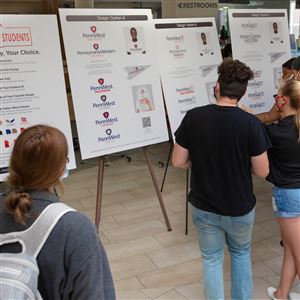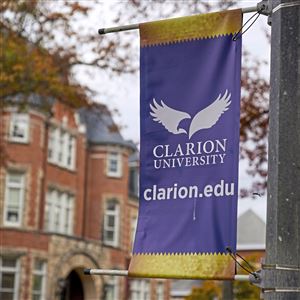Clarion University won Kathryn Robinson over with scholarship aid, welcoming professors and a modest $7,716 yearly tuition plus $3,500 in fees.
But classroom costs no longer tell the real story of paying for college.
That’s especially true across Pennsylvania’s 14 State System of Higher Education universities, where prices now vary by up to $6,500 a year, driven largely by campus-level decisions over the years to build high-end housing, dining and recreation venues to compete for students in a state whose government is known as being stingy toward higher education.
As officials merging six of those universities, including Clarion, recruit their first class for next fall at the two combined institutions, how leaders align prices — if at all — could foreshadow how the wider system will use affordability to reverse steep enrollment losses.
On some campuses, it literally costs a student more right now to be housed and fed than educated.
At Clarion, for instance, once room and board are added in, the total average cost per year jumps from $11,173 to $23,083.
Ms. Robinson, 21, of McDonald, said she knew that affording college would be a stretch for herself and her parents, so she set about seeking campus employment, landing a job as a residence hall assistant.
“I don’t pay for room and board. That makes it easier for me,” said Ms. Robinson, a junior with a dual secondary education major in English and social studies.
Ms. Robinson, whose father is a pastor and whose mother works for a bank, said she understands that attractive, high-end housing costs more, as do some of her peers.
But whatever leaders decide, she added: “I hope they keep students in mind. We are the reason they are here.”
‘It’s not only about costs’
Almost 89,000 students attend one of the 14 universities, down from nearly 120,000 in 2010.
The six universities that are poised to become two in August are less divergent in price than other system campuses. But a consultant warned in 2012 that five of those universities have the highest share of students from modest means who are most vulnerable to any price increase.
Among campuses being merged in Western Pennsylvania, Clarion carries the highest average total price, at $23,083, followed by California University of Pennsylvania at $21,524 and Edinboro University at $20,463.
In the northeast, Mansfield University is the highest at $23,100, followed by Bloomsburg University at $21,389 and Lock Haven at $21,246.
Systemwide, Indiana University of Pennsylvania is the most expensive, with an average total cost of $25,714, driven by both newer residence halls and other development, plus a decision several years ago to replace the reduced flat rate for full-time tuition with per-credit pricing.
IUP’s enrollment, at 9,308 students, has fallen by 38% from 15,126 in 2010, in a part of Pennsylvania with declining population.
Meanwhile, the system’s least expensive campus is its largest and fastest-growing: West Chester University, outside Philadelphia, at $19,195. Its enrollment during the same period has ballooned by 22%, though it dipped slightly this year by 79 students and stands at 17,640.
IUP spokeswoman Michelle Fryling defended her school’s price policies Wednesday, noting student successes, investments such as a new science hall and other programs, and a strong alumni network.
“There are a lot of things that we are doing to create a university that really works for the right person. It’s not only about costs,” she said.
Can't go back
State System leaders say they are working to address affordability across the 14 former teachers colleges that under Act 188 of 1982 became the State System. The legislation promised a college education for Pennsylvanians “at the lowest possible price.”
For the last three years, leaders have frozen in-state tuition at $7,716, and Chancellor Daniel Greenstein, who arrived in 2018, says he hopes a requested boost in state funding will enable him to freeze prices a fourth. Already, the rates are less than half what tuition costs at the University of Pittsburgh or Penn State University.
There are challenges beyond affordability, including how to refocus academic programs to support fields that are now most in demand, system officials said. But price is the issue that is perhaps the most personal, hitting prospective students and families who are touring campuses this fall in the wallet.
State System spokesman Cody Jones said leaders can only address what they control.
“We can't go back in time and stop people from making bad decisions,” Mr. Jones said this week, referring to construction debt from a $1 billion-plus building boom over the last two decades that now is a drag on the campuses.
The State System wasn’t alone in a national rush to create impressive amenities including attractive residences and recreation centers to attract a generation of students who came to expect those things.
But in Pennsylvania, cost, politics and demographics caught up.
This state has long ranked 47th out of 50 states in public support to higher education, and parts of the state already were seeing declines in high school graduates as the system’s last new dorms were being built.
“In hindsight, it probably wasn’t the best thing do to,” said Mr. Jones. “I can’t go back … and say ‘Hey, it’s not going to be a good decision to build those suite dorms on campus.’ ”
Under Mr. Greenstein, the system has done what the Legislature asked of it to rein in costs, Mr. Jones said. The chancellor is hoping legislators, therefore, will support an expanded request that includes debt relief to the campuses.
“It’s not fair for students in rural Pennsylvania and their families to spend up to 35% or 40% of their family income to go to one of our schools,” Mr. Jones said.
Approved by the system board last month, the appropriation request would boost by 15% next year’s State System appropriation to $550 million — a $73 million increase — as well as tens of millions for student aid and relief for campuses saddled by dormitory and other debt.
That’s in addition to a one-time funding package to aid in system redesign.
‘This is not unprecedented’
Some experts have long wondered why Pennsylvania and the State System left consequential decisions such as housing and recreation projects to individual universities’ councils of trustees, whose members were caught up in the rush to compete with other schools.
Each year, the tuition vote by the State System’s board of governors in Harrisburg draws statewide attention. But individual campus decisions to raise fees draw far less notice.
“It’s always politically easier to raise costs like room and board than it is tuition,” said Joni Finney, a policy analyst and recently retired director of the Institute for Research on Higher Education at the University of Pennsylvania. “But for students and families, they’re still writing the checks.”
Ms. Finney said if officials do not move quickly to rationalize pricing, trouble may follow.
For instance, how will admissions staff recruiting for a now unified institution steer students who could study at multiple locations: Will it be based on total campus price? Proximity to their hometown? The dorms that happen to have the most vacancies?
“They are not going to be able to explain this to the students they are trying to recruit,” she said. “Financial aid is a morass now, and they try all of this. It doesn’t make sense.”
Members of the Republican-majority state Legislature have long said the State System must spend money more efficiently. Groups in Pennsylvania contend the root problem actually is state itself and its financial support — or lack of it — for college-going students.
“The Pennsylvania legislature is to blame for unaffordable higher education in Pennsylvania. Period. PA ranks near rock bottom in the nation for its support of higher education. When the state is cheap, students and their families are left to shoulder an enormous financial burden,” said Susan Spicka, executive director of Education Voters of Pennsylvania.
Jamie Martin, president of the State System’s 5,000-member faculty union, said support for classroom endeavors is important. So is providing a reasonable price so student can live on the campuses where they learn.
“Tuition and classroom fees are the place to start, but our students deserve affordable housing options, too. Students shouldn't have to decide between paying tuition, paying rent and paying for food,” said Ms. Martin, who teaches at IUP and is president of the Association of Pennsylvania State College and University Faculties.
Leaders of the campuses being merged declined a request to interview a financial administrator involved in the pricing deliberations.
Instead, Cal U spokeswoman Christine Kindl issued a statement from Jim Geiger, head of advancement for what will be called Pennsylvania West University, or PennWest:
“It takes time to align these very complex functions across three universities. We are taking things step by step. Students will have the information they need, including costs, so they can select their campus.
“This is not unprecedented. Many universities have multiple tiers of housing at different prices, for example, or fees that apply to particular majors only.”
Tom McGuire, a spokesman for the Northeast mergers said:
“It is anticipated that by the fall 2025 academic year, all tuition/non-auxiliary fees and institutional aid practices will be aligned. Room, board, and other auxiliary fees (recreation center and student union) are expected to remain separate by campus location.
’’It is simply too early to say whether or not this will always be the case,” he said. “Long-term debt relief would allow the universities to provide more affordable housing options for students.”
For now, State System leaders are dealing with the situation they have inherited.
Ms. Robinson is a student member of Clarion’s council of trustees, while John Wheeler serves on Edinboro’s.
Mr. Wheeler, a psychology major from nearby Albion, expressed confidence in efforts to control costs — but he also noted that the issue is complicated.
”While the overall goal is to align the fees as close as they can, it can be a very tricky matter,” said Mr. Wheeler. “This is because each university has different assets and services, which drive the fees. ... It would be almost impossible to have the same room and board fees because the three universities have different residential buildings for students.”
Bill Schackner: bschackner@post-gazette.com, 412-263-1977 and on Twitter: @Bschackner.
First Published: November 18, 2021, 4:43 p.m.


















